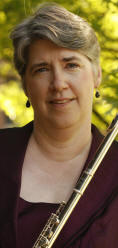Monday, November 30, 2015
IN THIS ISSUE:
Developing Flute Vibrato | Pics from the Classroom
Developing Flute Vibrato by Dr. Cate Hummel
This article originally appeared in the TBA Journal in September, 2002. The article is reprinted here with permission of the author. For a printable PDF of the entire article, please click here.
 Vibrato is an integral part of beautiful flute playing. How do you go about learning how to play with vibrato? Where does it come from in the body? How do you learn to use it to enhance your playing?
Vibrato is an integral part of beautiful flute playing. How do you go about learning how to play with vibrato? Where does it come from in the body? How do you learn to use it to enhance your playing?
The first question is a very simple one to address. There are two components to vibrato: speed and amplitude (see diagram at left). In order for vibrato to become a useful component of your playing, you must learn to control both of these parameters. Try this experiment. Place your hand over your solar plexus (just underneath the bottom of your rib cage) and cough. Did you feel the muscle of your upper abdomen contract? Now do the same thing without engaging your throat in the exercise. It should sound like a forceful "Huh!" if you are doing it correctly. You should feel those same muscles contract again. Now see if you can do a number of "Huh's" in a row like this: Huh-uh-uh-uhuh. Try it slowly at first, then gradually speed it up.
Now it’s time to experiment with your flute. First choose a note that is easy to play like a B in the middle of the staff. Play it with a full, steady sound. Make sure you are blowing evenly and steadily. No inadvertent wobbles! Listen carefully! Be absolutely certain that you can play with a strong and even air stream before you start learning vibrato. Otherwise you can make a bad situation worse. The basis for good vibrato is first learning to play with an even air stream. When you are confident that you are blowing evenly you can begin your exploration of vibrato.
Set your metronome at about 60bpm to start out. Marcel Moyse’s famous tone exercise is great to use for this practice (see the diagram below). Start out by playing half notes, B to Bb, using the same kind of breath pulse we talked about above and pulse the air in eighth notes. When you can progress all the way to the bottom of the flute, moving by half-step, pulsing in eighth notes, try the same thing now pulsing in triplets. Next do the same thing pulsing in sixteenth notes to the bottom and finally in quintuplets. After you have gotten comfortable doing this through the low register of the flute, do the same thing through the middle register and finally up through the third octave. Though you will never play with a vibrato as slow as eighth notes, it is good practice in learning to control the speed of your vibrato. Make sure your vibrato is distinctly wavy whatever speed or register you play.
You may notice a distinct difference in how vibrato feels to produce in the different registers. The other thing that you may notice is that it takes much more air to play with vibrato than without. As you get better at playing with vibrato, you will not notice either of these phenomena as much. You will improve at taking in enough air and learning to ration it more efficiently as you get more proficient with vibrato.
The second question, where vibrato comes from in your body, is a complex one for which there seems to be no specific answer. Unlike string players who anyone can observe producing vibrato with their left hand, a flutist’s vibrato emanates from inside the body. Scientists have demonstrated that many different muscle groups are involved including the diaphragm, abdominal wall and throat. Unless you are interested in the specific physiology of flute vibrato, it seems as if the specifics are not really necessary to understand as long as the quality of the sound with vibrato is within some basic parameters. Probably the most important question you can ask yourself is whether your throat is open and the air stream is moving freely while using vibrato? If you close off your throat while you are generating vibrato, the result will be a so-called "nanny goat" or "machine gun" vibrato that is too fast and not much good for expressive purposes.
The most difficult question to give a direct answer to is the last, using vibrato to play expressively. Though it is relatively easy to learn to play with vibrato and control the speed and amplitude of vibrato, it can be a lifelong task to understand how to use it to enhance the music and to clarify the composer’s intention. If you are studying with a teacher, they can help guide you in using vibrato musically. Even if you are not studying presently, there are some basic guidelines you can follow which can help you develop your musicianship and understanding.
Listen to lots of soloists - flutists, string players and singers. Pay careful attention to how much, where, and when these artists use vibrato. There is no better teacher than your own thoughtful and analytical listening. If you can hear what someone is doing, chances are you can teach yourself to imitate it.
It is counterproductive to count the pulses of your vibrato when you are playing after you have learned to control the speed. Doing it this way is too cold, analytical, and scientific. Using vibrato has to do with warmth, emotion, and life itself. Think instead of the emotional content of the music. Passionate music demands a fast, deep vibrato. On the other hand, mysterious music might use a very shallow, quick vibrato. Something that is more lyrical requires a slower, shallow vibrato.
Know the rules of musical syntax. Music is a language just like English, French and Swahili. Each language has rules for word order (phrasing in music). For starters, there are strong and weak beats in a measure with the first beat always the strongest unless displaced by an accent. The basic musical impulse is to move from weak to strong beats regardless of the notation. Bar lines look like stop signs but are actually green lights. Go from the last beat of the measure to the first beat. (This is similar to how string players play an upbeat with an up bow and a weaker stroke, and a strong beat with a down bow and a stronger stroke.) You would not use vibrato on a weak beat because it draws undue attention to it. Use vibrato to help show the strong beats. Your audience does not have the benefit of seeing the music so you have to show them by how you play what is on the page. The more clearly you speak the language, the more effective your performance.
Vibrato is unnecessary in rapid passages. It sounds fussy and affected. Above all, remember to use vibrato to enhance the phrase. Vibrato is not a switch on an electric organ to turn on and use indiscriminately.
Above all, have fun as you learn to incorporate vibrato into your playing. Vibrato adds color, vitality, and interest, both for you and for your audience. Practice well!
 |
Dr. Cate Hummel Dr. Hummel currently serves as Adjunct Professor of Flute at the University of St. Francis in Joliet, IL. She received her MM and DMA from the Manhattan School of Music in New York. She has been a performer, flute instructor, clinician, and chamber music coach in the Chicagoland since 1992. She is the founder and director of Dr. Cate's Flute Camp in Naperville since 2000, for flute students ages 11-15. Dr. Hummel maintains two websites: Dr. Cate's Flute Tips and The Fluteline. She is a clinician for Altus and Azumi flutes. For additional information on Dr. Hummel, please visit her website. |

